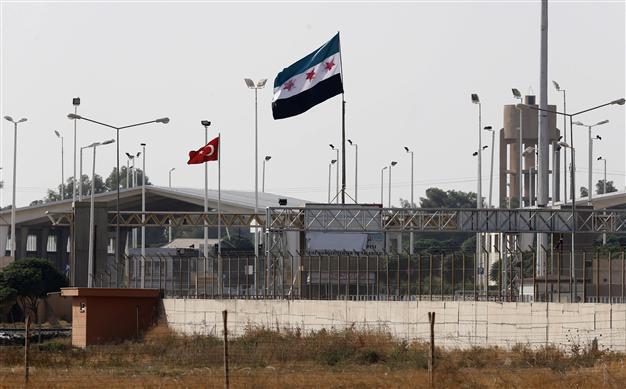Turkey hit Syria with S. Korean-designed howitzers
ANKARA - Hürriyet Daily News

Turkish (L) and Syrian Independence flags are seen between the border gates Akcakale of Turkey and Tel Abyad of Syria, in Akcakale, southern Sanliurfa province, October 4, 2012. REUTERS Photo
Turkey hit Syrian targets on Wednesday using the South Korean-designed T-155 Firtina howitzers, in retaliatory shelling of its southern neighbor.The K9 Thunder was developed for the Korean Army by Samsung Techwin and its building license was first obtained by Turkey in 2004 for nearly $1 billion. Turkey has renamed the K9 Thunder “Fırtına,” which is the Turkish word for “storm.” Turkey has paid for a total of nearly 350 howitzers.
Though essentially using the main systems of the K9 howitzer - including the South Korean designed 155/52 caliber gun system, the majority of the chassis, the automatic ammunition feeding mechanism, and the German designed MTU-881 KA 500 diesel engine - the T-155 has considerable differences in its turret design, parts of its chassis, the navigation system, and the electronic system, such as the radio and fire control system that were developed in Turkey. Unlike the K9, the T-155 Fırtına lacks a commander’s digital panoramic sight. Through the Inertial Navigation System produced by Turkey’s military electronics conglomerate Aselsan, the howitzer is able to determine the coordinates of the targets at 17.5 meters deviation. Fırtına can open fire within 30 seconds.
According to the license agreement Samsung Techwin, the first eight T-155s were built in South Korea, while the remaining batch of more than 300 units will be produced in Turkey. The total reported cost of purchase and technology transfer for the Turkish government was $1 billion.
T-155 Fırtına has a maximum firing range of 40 km, depending on the type of ammunition. It can reach a top speed of 66 km/h and has an operational range of 480 km.
The T-155 howitzers are built at the 1st Army Maintenance Center Command of the Turkish Army in Adapazarı. The production rate of the T-155 is 24 units per year. From 2001 to December 2009, more than 150 units have been delivered to the Turkish Army.
Turkey and South Korea have been close partners since the 1950 Korean War that broke out with North Korea, which was backed by China.
Turkey will also complete a 40-plane basic trainer program with South Korea on Monday, Oct. 8. Korea Aerospace Industries (KAI) and Turkish Aerospace Industries (TAI), the leading aerospace companies of South Korea and Turkey, will deliver their last jointly-built basic trainer, the KT-1T, to the Turkish Air Force, officials close to the program said. The Undersecretariat for Defense Industries, Turkey’s defense procurement agency, signed a $350 million contract with KAI in 2007 for 40 KT-1Ts for the Air Force.
The KT-1T is the Turkish version of KAI’s KT-1 Woongbi, developed for South Korea, but it includes modifications required by the Turkish Air Force. KAI won the contract against several rivals, including U.S. company Raytheon and Brazil’s Embraer. The KT-1Ts will replace the aging U.S.-made T-37 trainer planes.
In the defense arena, Hyundai Rotem, a South Korean company, is providing technical assistance for Turkey’s efforts to design, develop and manufacture the country’s first main battle tank, the Altay. TAI and KAI are also considering the development of a fighter aircraft after 2020.
















